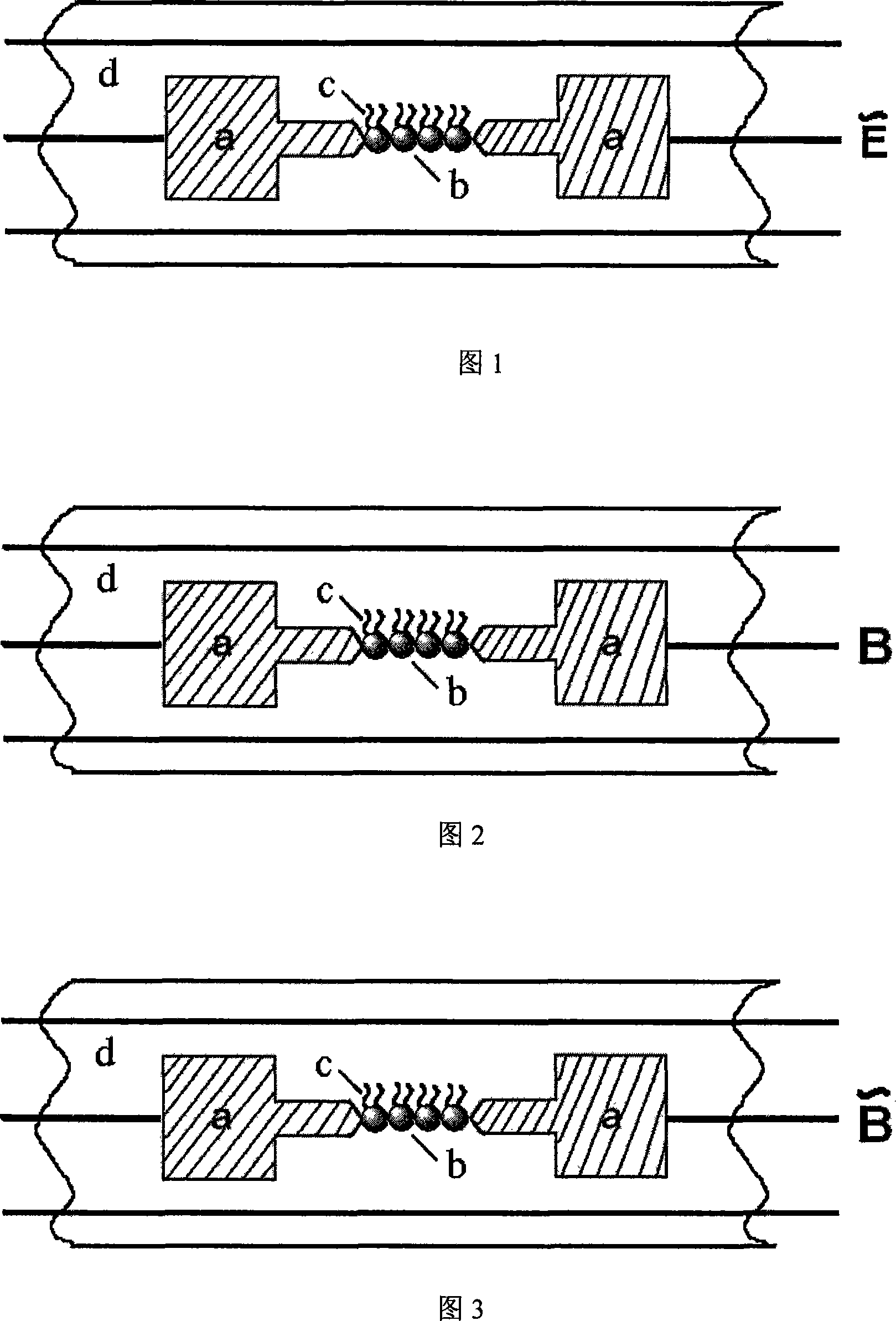Method for preparing biosensor by arraying nanometer particles in external field evoked electrode
A biosensor and nanoparticle technology, which is applied in the field of nanodevices and biosensors, can solve problems such as complex processes and sensor detection limits to be improved, and achieve the effects of high-sensitivity electrical response, simple and easy-to-control devices, and improved sensitivity
- Summary
- Abstract
- Description
- Claims
- Application Information
AI Technical Summary
Problems solved by technology
Method used
Image
Examples
Embodiment 1
[0034] Embodiment 1: Metal (gold, silver, platinum, copper, etc.) electrode pairs with nano-gap are processed on silicon-based materials by electron beam lithography or prior art (CN 1560904A). After degreasing the surface of the electrode with an organic solvent (acetone or ethanol), put it into a freshly configured piranha solution (sulfuric acid: hydrogen peroxide = 3: 1, volume ratio) for 15 minutes, take it out, rinse it with water, and use nitrogen flow Blow dry; then put the above electrode into the ethanol solution of the bifunctional molecular mercapto compound X-R-Y (such as mercaptoethylamine or 1,6-hexanedithiol, etc.) for molecular assembly; put the metal electrode assembled with the bifunctional molecule into In the solution of metal nanoparticles (gold, silver, copper, etc.) or II-VI semiconductor nanoparticles, an alternating electric field is applied along the direction of the electrode pair (the peak voltage of the alternating electric field is 10-2000V / cm, an...
Embodiment 2
[0035] Embodiment 2: Electron beam lithography or prior art (CN 1560904A) is used to process magnetic (nickel, cobalt, palladium) electrode pairs with nano-gap on silicon-based materials. After cleaning the surface of the electrode with an organic solvent (acetone or ethanol), put it into an ethanol solution of a bifunctional molecular mercapto compound X-R-Y (such as mercaptoethylamine or 1,6-hexanedithiol, etc.) for molecular assembly; The metal electrodes of functional molecules are placed in the solution of magnetic nanoparticles (nickel, cobalt, palladium, iron and their oxides and derivatives, etc.) with conductor or semiconductor properties, and a static magnetic field (magnetic field strength 1×10 -3 ~3T), induce the magnetic nanoparticles to be arranged in a chain structure at the tip of the electrode pair, connect the corresponding electrode pair, and form a circuit conduction in this direction; then put the electrode into a solution containing sensitive molecules fo...
Embodiment 3
[0036] Embodiment 3: Electron beam lithography or existing technology (CN 1560904A) is used to process magnetic (nickel, cobalt, palladium) electrode pairs with nano-gap on silicon-based materials. After cleaning the surface of the electrode with an organic solvent (acetone or ethanol), put it into an ethanol solution of a bifunctional molecular mercapto compound X-R-Y (such as mercaptoethylamine or 1,6-hexanedithiol, etc.) for molecular assembly; The metal electrodes of functional molecules are placed in a solution of magnetic nanoparticles (nickel, cobalt, palladium, iron and their oxides and derivatives, etc.) with conductor or semiconductor properties, and an alternating magnetic field (magnetic field Intensity range is 1×10 -3 ~3T, the frequency range is 10~10 8 Hz), induce the magnetic nanoparticles to be arranged in a chain-like structure at the tip of the electrode pair, and connect the corresponding electrode pair to form a circuit conduction in this direction; then ...
PUM
| Property | Measurement | Unit |
|---|---|---|
| Magnetic field strength | aaaaa | aaaaa |
Abstract
Description
Claims
Application Information
 Login to View More
Login to View More - R&D
- Intellectual Property
- Life Sciences
- Materials
- Tech Scout
- Unparalleled Data Quality
- Higher Quality Content
- 60% Fewer Hallucinations
Browse by: Latest US Patents, China's latest patents, Technical Efficacy Thesaurus, Application Domain, Technology Topic, Popular Technical Reports.
© 2025 PatSnap. All rights reserved.Legal|Privacy policy|Modern Slavery Act Transparency Statement|Sitemap|About US| Contact US: help@patsnap.com

